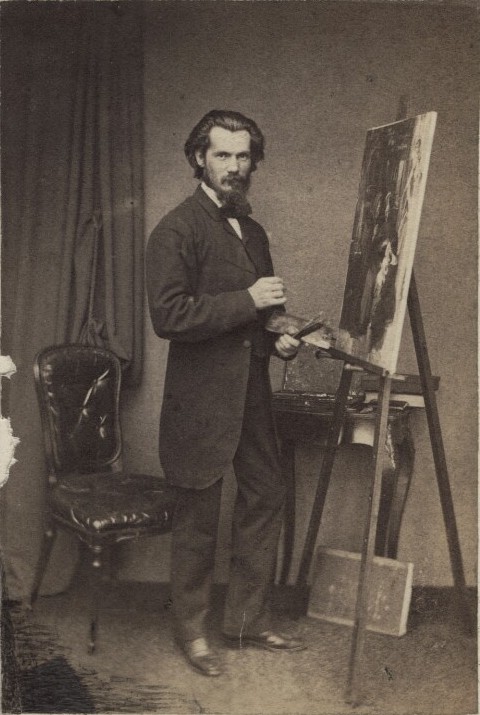
Collinson in the early 1860s [Click on the image for more details.]
Robert Collinson (not known to have been related to the Pre-Raphaelite artist James Collinson) studied at Manchester Art College and first showed his work at the Royal Institute in Manchester in 1851 (see FALMAG 1000.36), and at the Royal Academy in 1854 (see "Stray Rabbits). After some time he relocated to London, where he started teaching at at the South Kensington Schools in 1858. His painting, “Oh, bless its little heart!”, was very favourably reviewed in the Illustrated London News of January 1861. Another work, Subday Afternoon, which was shown at the Royal Academy in 1875, was praised by John Ruskin (see Wood 99).
Collinson rose to become rising Director of Studies in Figure and Painting at the Schools, and achieved some prominence in the art world, making his views heard publicly: for example, he complained in the Times about the unsatisfactory way Rossetti's work was shown in 1883, and spoke out strongly against siting the National Gallery of British Art by the Thames at Millbank, where the old prison had been (and where the Tate was built). His remarks on Rossetti reveal a keen appreciation of the artist's work: "'To art students,' he continued, 'these pictures are a most valuable lesson as examples of magnificent colour, draughtsmanship, and design, and for the deep earnestness and poetic inspiration pervading them all'" (Fredeman 198, n.32). Indeed, some of his own work shows the influence of the Pre-Raphaelites.
Collinson's address from 1880-1891 was 20 Hereford Square, South Kensington (see Johnson and Greutzner 116), but he kept his ties with Manchester, where he was elected a member of the Manchester Academy of Fine Arts in 1881, and, like so many other artists of the time, liked to paint in Falmouth, on the Cornish coast. His work is represented in Falmouth Art Gallery, as well as at the Ashmolean in Oxford, the Victoria and Albert Museum, and elsewhere. He exhibited 31 paintings at the Royal Academy from the first time it appeared there in 1858, until the last, in 1890. He is chiefly remembered now as a genre painter. Collinson's wife Eliza was also an artist: she painted flowers, and showed her work at the Royal Academy and the Society of British Artists (see Wood 100). — Jacqueline Banerjee
Bibliography
FALMAG 1000.36 (An Old Mill, Falmouth, item in the collection of the Falmouth Art Gallery. https://www.falmouthartgallery.com/Collection/1000.36)
Fredeman, William. "Pictures at an Exhibition: Late Victorian and Modern Perspectives on Pre-Raphaelitism." Victorian Connections, edited by Jerome J. McGann. University of Virginia Press, 179-199.
Hardie, Melissa, ed. Artists in Newlyn and West Cornwall. 1880-1940. A Dictionary and Source Book. Bristol: Art Dictionaries Ltd, 2009.
Johnson, A. and A. Greutzner, compilers. Dictionary of British Artists, 1880-1940. Woodbridge, Suffolk: Antique Collectors' Club, 1976.
“Oh, bless its little heart!”. Illustrated London News. Vol. 38. 5 January 1861. Internet Archive. Web. 13 March 2024.
Robert Collinson. CAI (Cornish Artists Index). Web. 13 March 2024. https://cornwallartists.org/cornwall-artists/robert-collinson
Stray Rabbits. V&A (Victoria and Albert Museum). https://collections.vam.ac.uk/item/O16498/stray-rabbits-oil-painting-collinson-robert/
Wood, Christopher. The Dictionary of Victorian Painters. 2nd ed. Woodbridge, Suffolk: Antique Collectors' Club, 1978.
Created 14 March 2024